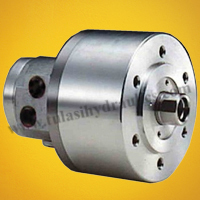

Tulasi Hydraulic Pvt.Ltd. is a prominent Manufactures and Suppliers of top-quality Rotary Cylinders, strategically located in Mumbai, with operationsin Navi Mumbai and Thane . As a leadingProvider and Exporter , we excel in fabricating advanced hydraulic solutions that cater to various industrial needs. Our manufacturing company is dedicated to producing reliable and efficient products, establishing us as a trusted dealer in the hydraulic equipment sector. With a focus on innovation and quality, Tulasi Hydraulic Pvt.Ltd. continues to serve clients across India and beyond.
A rotary cylinder, also known as a rotary actuator or rotary hydraulic cylinder, is a type of hydraulic or pneumatic actuator that is designed to provide rotary motion or torque around a fixed axis. These cylinders convert hydraulic or pneumatic pressure into mechanical rotary force, allowing them to rotate an attached load or component. Rotary cylinders have various applications across industries where controlled rotation is required. The cylinder body is the main housing that contains the internal components of the rotary cylinder. It typically has a cylindrical shape and provides structural support. Rotary cylinders have hydraulic or pneumatic ports for the inlet and outlet of hydraulic fluid or compressed air. These ports control the actuation and release of the cylinder. The rotating shaft or spindle is the component that rotates when hydraulic pressure is applied. It extends from the cylinder body and is connected to the load or component that needs to be rotated. Rotary cylinders are equipped with sealing mechanisms to prevent hydraulic fluid or compressed air leakage during operation. Seals are essential to maintain the integrity of the system and ensure efficient rotation. Rotary cylinders are typically controlled using hydraulic or pneumatic control valves that regulate the flow of fluid or air to the cylinder. These valves allow operators to control the speed and direction of rotation. Rotary cylinders can be mounted in various orientations and configurations to accommodate different rotational requirements. Common mounting options include flange mounts, foot mounts, and clevis mounts. Bearings are often incorporated into rotary cylinders to reduce friction and allow for smooth and efficient rotation of the shaft or spindle. Depending on the specific application, rotary cylinders may be equipped with accessories such as limit switches, position feedback devices, and locking mechanisms to enhance their functionality and control. In a hydraulic rotary cylinder, hydraulic fluid is supplied to one side of the cylinder, creating pressure that acts on a piston or vane inside the cylinder. This pressure causes the piston or vane to rotate, which, in turn, rotates the attached shaft or spindle.
By controlling the hydraulic pressure and direction, the speed and direction of rotation can be adjusted. In a pneumatic rotary cylinder, compressed air is used to create pressure imbalances on opposite sides of the cylinder, causing it to rotate. The direction and speed of rotation are controlled by regulating the flow of compressed air into and out of the cylinder. Rotary cylinders are used in conveyor systems, indexing tables, and packaging machinery to control the rotation of components. They are found in assembly lines for tasks such as component positioning and rotation. Rotary cylinders are used in food processing equipment for tasks like mixing and rotating products. They are employed in aircraft control surfaces, landing gear systems, and other aviation equipment. Rotary cylinders are used in CNC machining centers and milling machines for tasks such as tool changes and workpiece indexing. They are used in robotic systems to provide rotational motion to robot arms and end-effectors. Rotary cylinders are used in packaging equipment for tasks such as sealing and labeling. They are found in heavy equipment like excavators for precise bucket movement and other rotational tasks.